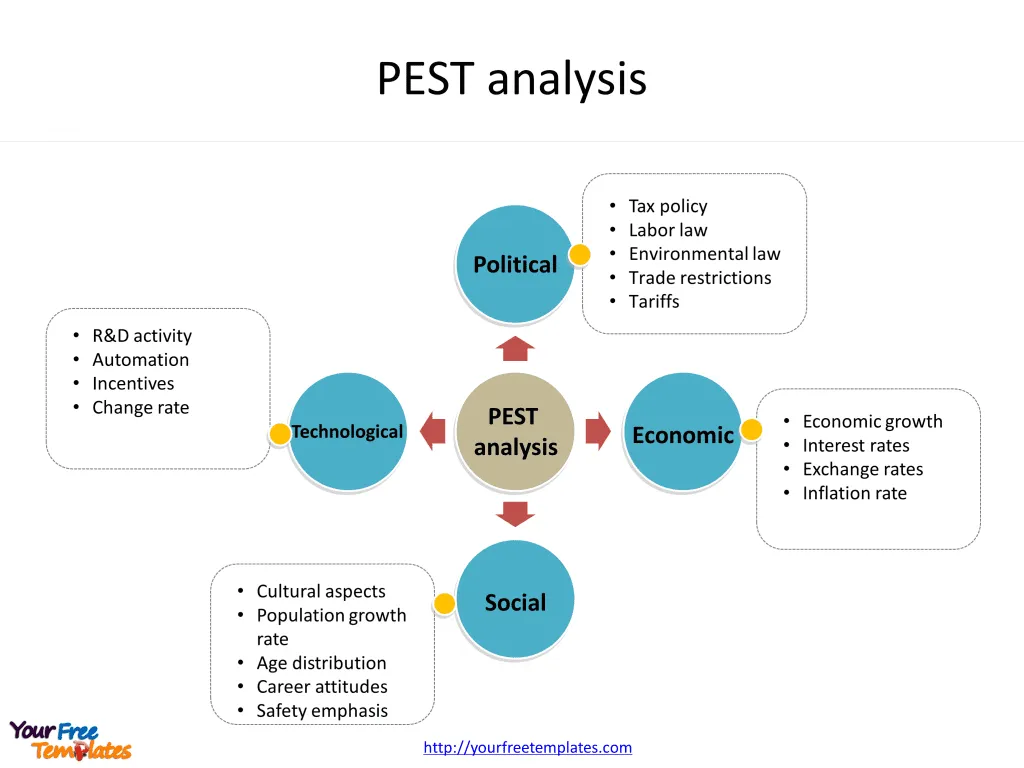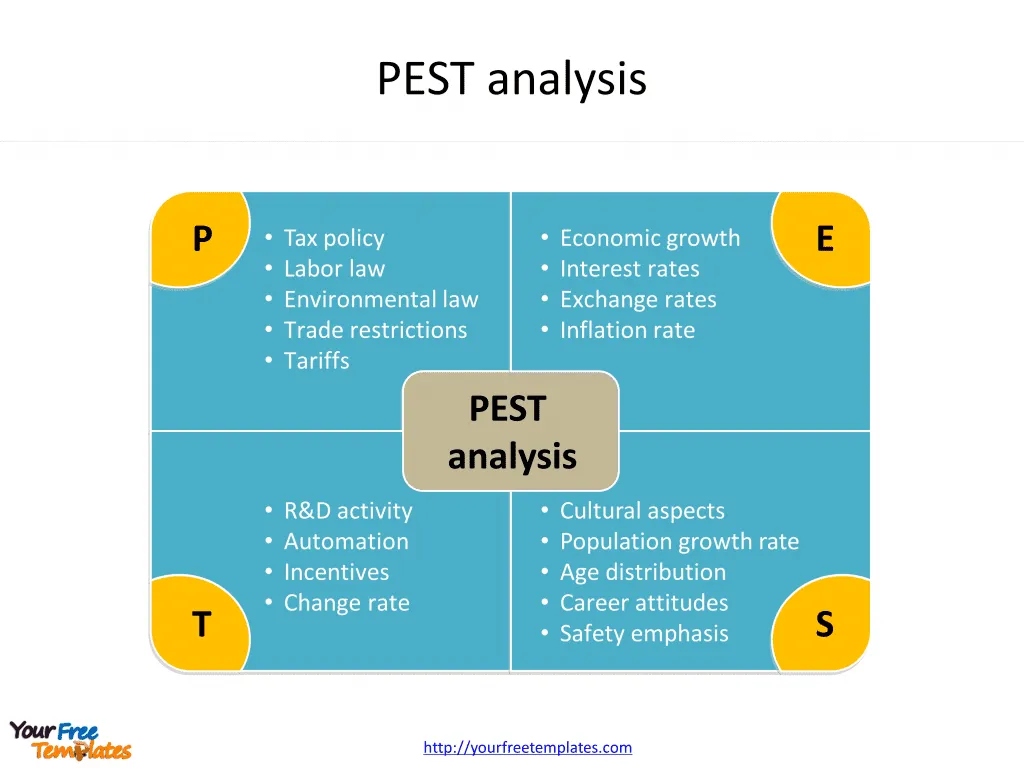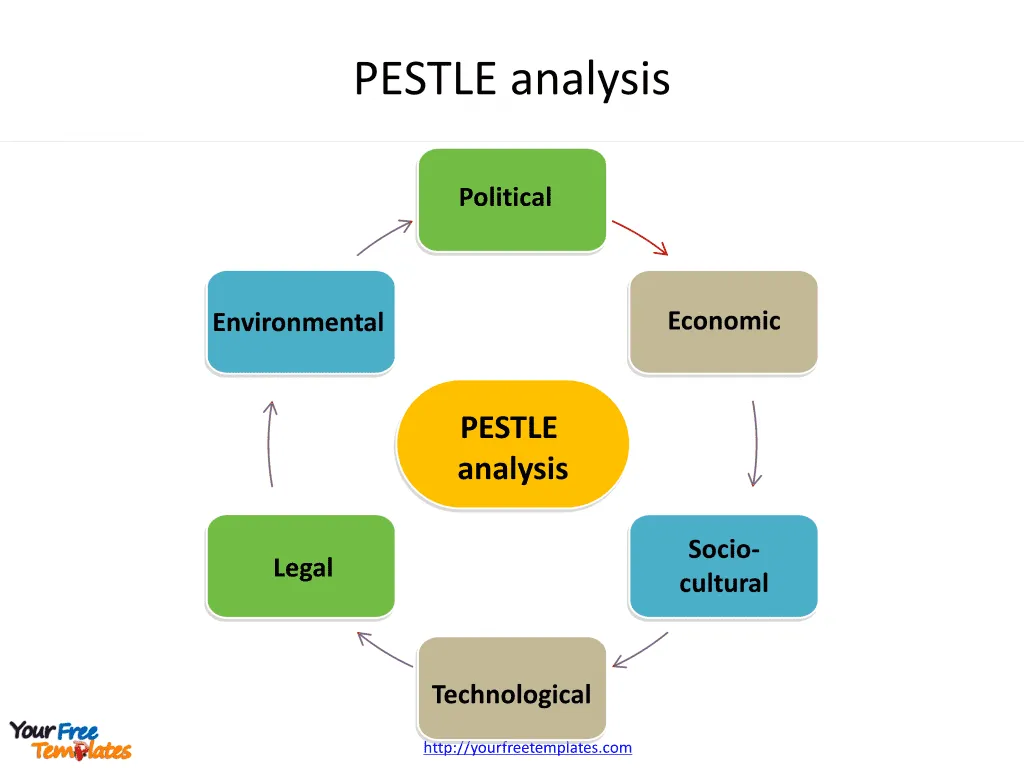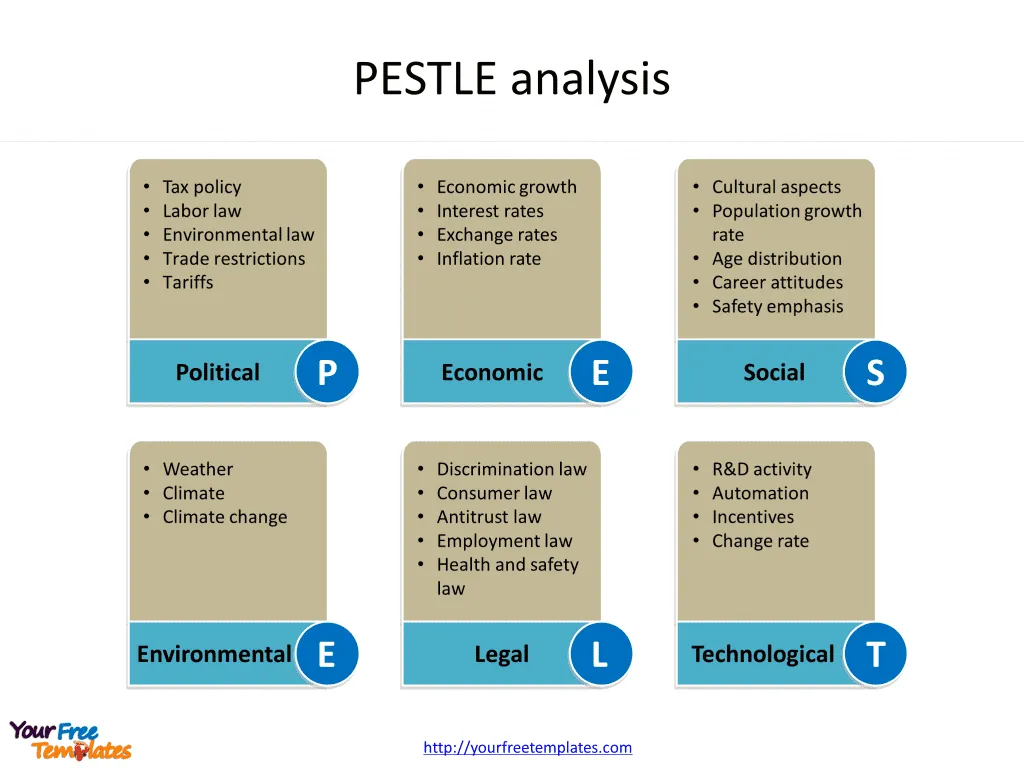The PEST analysis Template in PowerPoint format includes four slides. Firstly we have the PEST analysis in two formats. Secondly we present PESTLE analysis in different formats. As the same diagram PowerPoint template series, you can also find our Maslow’s hierarchy of needs, Data Mining, Machine Learning, cloud computing, Artificial Intelligence and BlockChain PowerPoint templates.
PEST analysis, a strategic planning tool, is valuable for businesses to comprehend the external macro-environmental factors that influence their operations. This comprehensive guide delves into the core elements of a PEST analysis, its practical applications, examples, and how it can aid in business strategy development.
What is PEST Analysis?
PEST, an acronym for Political, Economic, Socio-cultural, and Technological analysis, is a framework businesses use to identify external factors that may affect their operations. Pioneered by Harvard professor Francis Aguilar in 1967, it presents an overview of the macro-environmental conditions that a business needs to consider for strategic planning.
Slide 1 and 2, PEST analysis templates
Components of PEST
The analysis by PEST components comprises four main elements, each representing different external influences that could impact a business’s performance. Let’s delve deeper into these components:
Political Factors
Political factors encompass the government’s role, regulations, and impacts on the business environment. These include:
-
Upcoming political elections
-
Trade policies and tariffs
-
Government regulations on industry or competition
-
Level of corruption or organized crime in the region
-
Consumer and employee protection laws
Economic Factors
These factors involve the overall economic conditions that can influence a business’s operations. They include:
-
Current economic stability
-
Projected growth and inflation rates
-
Interest rates and fiscal policies
-
Consumer habits and financial stability
-
Unemployment rate and competition for jobs

Socio-cultural Factors
Socio-cultural factors focus on the societal and cultural aspects that can affect the market environment. These factors include:
-
Population growth and demographics
-
Generational shifts
-
Consumer habits and values
-
Family size and structure
-
Attitudes toward work
Technological Factors
Technological factors relate to the impact of technological advancements and trends on an organization. These include:
-
The organization’s access to new technology
-
Rate of technological change
-
Evolution of infrastructure
-
Government or institutional research
Purpose and Goals of PEST Analysis
Analysis from PEST serves multiple purposes in strategic business planning. The primary goals of a PEST analysis are:
-
Understanding the current external influences on the business
-
Identifying potential future changes in these factors
-
Mitigating risks and capitalizing on opportunities
-
Developing a long-term business strategy
How to Conduct a Analysis from the perspectives of PEST
Conducting a PEST analysis involves a systematic approach to gathering and analyzing data. Here is a step-by-step guide to help you through this process:
Step 1: Consider PEST Factors
Start by researching and gathering as much information about your organization’s external influences as possible. Brainstorm with other leaders or managers in the business to ensure you have a comprehensive data set.
Step 2: Identify Opportunities
Once you’ve researched the various ways your organization is influenced by external conditions, identify the potential opportunities these changes could provide.
Step 3: Identify Threats
Recognize potential threats to your organization so you can mitigate the risks and adapt your strategy accordingly.
Step 4: Act on Your Findings
With all your data collected and your opportunities and threats outlined, it’s time to incorporate these findings into your business plan to manage threats and take advantage of opportunities as soon as possible.

PEST Analysis Example
Let’s consider a fictitious company, XYZ Tech, that develops mobile applications. Here is a brief example of how they could perform a analysis from the angle of PEST:
-
Political: XYZ Tech needs to consider the regulations governing data privacy and digital content in the countries they operate in. They also need to assess the impact of potential changes in trade policies that could affect their offshore development teams.
-
Economic: The company should analyze economic indicators such as inflation rates, consumer purchasing power, and overall economic stability. Economic downturns could influence their pricing strategies and affect their profit margins.
-
Socio-cultural: XYZ Tech should consider the changing demographics of their target market, cultural attitudes towards technology, and trends in mobile application usage.
-
Technological: The company must stay updated with advancements in mobile technology, changes in smartphone penetration, and competitor’s access to technology.
PEST Analysis Vs. SWOT Analysis
While PEST one provides a macro-level view of the market environment, SWOT analysis focuses more on the organization itself, identifying its strengths, weaknesses, opportunities, and threats. Both these analyses are often used together for a comprehensive understanding of the business environment.
When to Do a PEST Analysis
A PEST analysis is best utilized when you need a broader understanding of your business environment. Some of the ideal times to conduct a PEST analysis include:
-
When starting a new business
-
When a significant problem is identified
-
When/if your business is pivoting
-
When you recognize impending changes in one area and want to re-evaluate the market
Slide 3 and 4, PESTLE analysis templates.
PESTLE Analysis is a strategic management tool that is used to identify, analyze, and monitor the macro-environmental factors that have Political, Economic, Social, Technological, Legal, and Environmental aspects of the environment in which the business operates. The PEST factors are the same ones mentioned above, the two new added factors are followed.
- Legal Factors:
- Current and upcoming legislation in your market
- Employment laws
- Consumer protection laws
- Health and safety laws
- International as well as trade regulations and restrictions
- Environmental Factors:
- Environmental regulations
- Ecological environment
- Climate change
- Sustainable practices
- Waste disposal laws
- Energy consumption regulation

Purpose of PESTLE Analysis
PESTLE Analysis helps organizations to:
- Understand external factors: It enables businesses to look outside of their narrow focus and understand broad, non-controllable external forces that might affect the organization.
- Strategic Planning: It aids in strategic planning by ensuring that the organization’s strategy is aligned with the external environment.
- Risk Management: It helps in identifying potential risks and enables the organization to take preventive or corrective actions.
- Opportunity Identification: By understanding the environment, organizations can leverage opportunities that might otherwise be missed.
- Decision Making: It provides a factual basis for making decisions, instead of relying on intuition.
- Change Readiness: It prepares organizations for change, allowing them to anticipate the impact and respond effectively.
PESTLE Analysis is often used in conjunction with other strategic analysis tools such as SWOT (Strengths, Weaknesses, Opportunities, Threats) analysis to give a clear understanding of the external environment and how it might affect a business.

Limitations of this Analysis
While PEST analysis is an effective strategic tool, it also has some limitations:
-
It can quickly become outdated due to the dynamic nature of external environments
-
It involves some degree of speculation and assumption, which could lead to inaccuracies
-
It could lead to information overload due to the large data sets involved
Wrapping Up
PEST analysis, while not a silver bullet for all business challenges, is a crucial tool in the arsenal of any organization looking to understand and navigate the larger forces at play in their industry. By combining PEST analysis with other strategic tools like SWOT analysis, businesses can gain a holistic view of their environment and make informed decisions that contribute to their long-term success.
For detailed info on this analysis, please refer to Wikipedia.
Size:92K
Type: PPTX
Aspect Ratio: Standard 4:3
Click the blue button to download it.
Download the 4:3 Template
Aspect Ratio: Widescreen 16:9
Click the green button to download it.
Download the 16:9 Template











